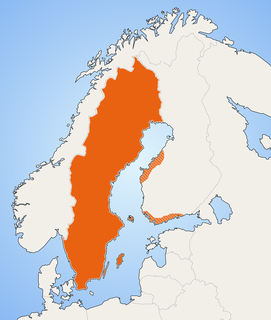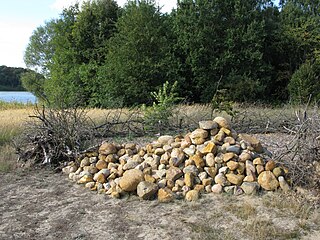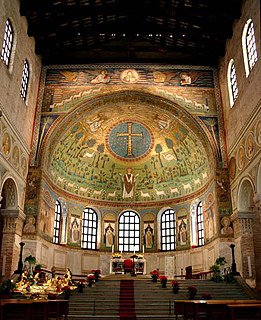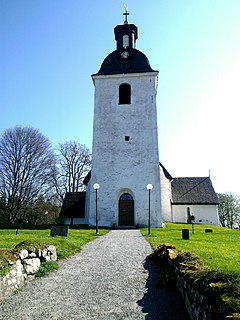
Bromma kyrka is a round church in the borough Bromma in Stockholm, Sweden. The oldest parts of the church were built in the later 12th century as a fortress church, and the church is among Stockholm's oldest buildings.

Torshälla Church is a medieval church building in Torshälla, Sweden, in the Church of Sweden Diocese of Strängnäs. It serves as the Lutheran town parish church of Torshälla parish and is located at the Rådhustorget market square.

Yttergran Church is a medieval Lutheran church in the Archdiocese of Uppsala in Uppsala County, Sweden.
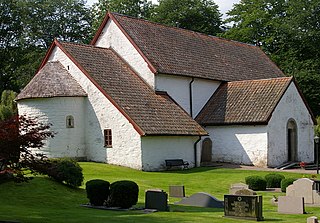
Gökhem Church is a medieval Lutheran church built in the Romanesque style. Located some 12 km (7.5 mi) west of Falköping in Västra Götaland County, Sweden, it belongs to the Diocese of Skara. One of Sweden's oldest stone churches, it is noted for its well-preserved 15th-century frescos, possibly the work of Master Amund.

Brunnby Church is a medieval Lutheran church about 9 km (5.6 mi) north of Höganäs in southern Sweden. It belongs to the Diocese of Lund. The church is noted for its many 15th-century frescos, attributed to the Helsingborg Workshop.

Skepptuna Church is a medieval Lutheran church in the Archdiocese of Uppsala in Stockholm County, Sweden.

Häverö Church is a medieval Lutheran church in the Archdiocese of Uppsala in Stockholm County, Sweden.

Enåker Church is a Lutheran church located a few kilometres north-east of Sala in the Archdiocese of Uppsala in Uppsala County, Sweden.

Bro Church is a Lutheran church Bro in the Archdiocese of Uppsala in Stockholm County, Sweden, located approximately halfway between Stockholm and Enköping.

Balingsta Church is a Lutheran church in the Archdiocese of Uppsala in Uppsala County, Sweden. It is one of the best preserved Romanesque churches in the province of Uppland..

Härkeberga Church is a Lutheran church in the Archdiocese of Uppsala in Uppsala County, Sweden. It contains a number of well-preserved 15th-century frescos attributed to Albertus Pictor.

Vänge Church is a Lutheran church at Vänge in Uppsala County, Sweden. It lies in the Archdiocese of Uppsala of the Church of Sweden.
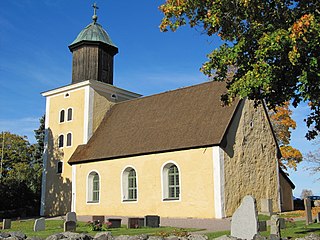
Läby Church is a Lutheran church in the Archdiocese of Uppsala in Uppsala County, Sweden. It is located on the main road between Uppsala and Sala, and is the rural church closest to Uppsala city.

Nederluleå Church is a medieval Lutheran church in Gammelstaden near Luleå in Norrbotten County, Sweden. It belongs to the Diocese of Luleå. The church is the largest medieval church in the Swedish land of Norrland. It forms a part of the UNESCO World Heritage Site Gammelstad Church Town.

Boglösa Church is a medieval Lutheran church in the Archdiocese of Uppsala a few kilometres south of Enköping in Uppsala County, Sweden.

Tierp Church is a Lutheran church in Tierp, Uppsala County, Sweden. It belongs to the Archdiocese of Uppsala. The church is one of the largest countryside churches in Uppland and contains well-preserved medieval frescos.
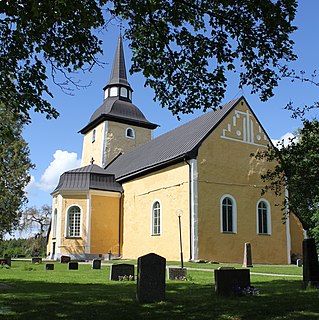
Enköpings-Näs Church is a medieval church approximately 10 kilometres (6.2 mi) south of Enköping in Uppsala County, Sweden. It belongs to the Church of Sweden.
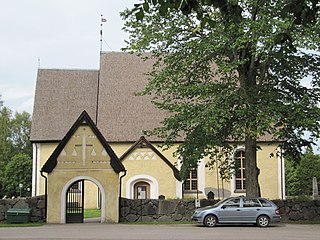
Stavby Church is a medieval church located north-east of Uppsala in Uppsala County, Sweden. It is part of the Archdiocese of Uppsala.

Rasbokil Church is a medieval church located north-east of Uppsala in Uppsala County, Sweden. It is part of the Archdiocese of Uppsala.
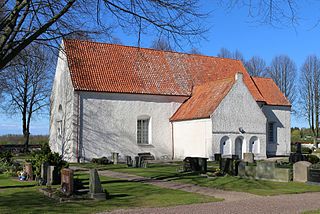
Gualöv Church is a medieval church in Gualöv, Bromölla Municipality, in the province of Skåne, Sweden. The church contains several medieval frescos and a medieval altarpiece.

